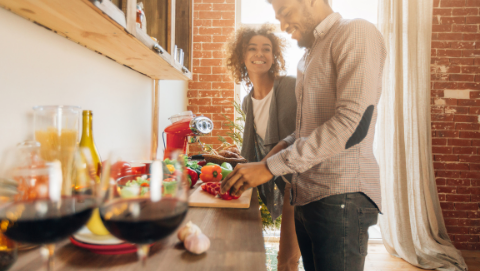Please give us feedback on one of our weekly question and answer articles. We value your time so the evaluation will only take 3 minutes or less, we promise!
Take the Survey »Creating Connections Through Cooking
By April Litchford, Extension Assistant Professor The connection between cooking at home and health has been explored for many years. Regular at home cooking has been tied to improved psychosocial and physical health. The act of providing good, nourishing food for our bodies helps create a sense of flourishing that is thought to be a necessary behavior to promote health (Farmer & Cotter, 2021; Gordon, 2020). One reason for this association could be that people who cook generally eat fewer calories and more fruits and vegetables which improves their physical health. But there is more to cooking than just a physical benefit. Cooking requires us to learn and use multiple life skills from planning what we will eat, to purchasing the ingredients, to preparing the meal. There is satisfaction in completing the whole circle with food. Also, cooking is a form of self-expression and a way to participate in creativity which can contribute to self-efficacy and mastery (Farmer & Cotter, 2021). Lastly, cooking gives us the ability to bring joy to other people. All human beings have a biological need to eat food and we generally really enjoy eating! Food is an amazing part of our lives that brings interest and excitement, there are so many flavors and texture combinations. With food there is always something new to try and experience. Cooking, serving food, and eating with others connects people at a basic level despite the diversity of cultures and generations, many individuals report a higher sense of well-being when they have meals with family and loved ones (Farmer & Cotter, 2021).
The connection between cooking at home and health has been explored for many years. Regular at home cooking has been tied to improved psychosocial and physical health. The act of providing good, nourishing food for our bodies helps create a sense of flourishing that is thought to be a necessary behavior to promote health (Farmer & Cotter, 2021; Gordon, 2020). One reason for this association could be that people who cook generally eat fewer calories and more fruits and vegetables which improves their physical health. But there is more to cooking than just a physical benefit. Cooking requires us to learn and use multiple life skills from planning what we will eat, to purchasing the ingredients, to preparing the meal. There is satisfaction in completing the whole circle with food. Also, cooking is a form of self-expression and a way to participate in creativity which can contribute to self-efficacy and mastery (Farmer & Cotter, 2021). Lastly, cooking gives us the ability to bring joy to other people. All human beings have a biological need to eat food and we generally really enjoy eating! Food is an amazing part of our lives that brings interest and excitement, there are so many flavors and texture combinations. With food there is always something new to try and experience. Cooking, serving food, and eating with others connects people at a basic level despite the diversity of cultures and generations, many individuals report a higher sense of well-being when they have meals with family and loved ones (Farmer & Cotter, 2021).
The benefits connected to cooking are truly amazing and can enhance life, but there is also a benefit for marriage relationships. When we cook, we are providing sustenance for our bodies and connecting to others as we make food and eat with them. When couples cook together it can strengthen relationship skills, provide an emotional connection, and build a better understanding of language and how we communicate with each other (Gordon, 2020). Regular time cooking with a spouse is connected to building a stronger, resilient relationship (Borden, 2018; Gordon, 2020). The act of cooking draws people together because everyone has a biological need to nourish their bodies. How we choose to do that is a very personal experience. When couples cook together, they learn that practice makes perfect, that compromise is needed when deciding flavors and ingredients, and that problem solving and working together is necessary for creating a successful meal (“Cooking & Relationships at Flavorful Fridays.,” 2021). These skills translate into other situations in life and give couples the ability to build stronger relationships that sustain them through stress and struggle. Couples that cook together learn to reframe failures as learning experiences, they also learn better ways to communicate, they understand the need to spend time together having fun, and they learn to keep practicing (“Cooking & Relationships at Flavorful Fridays.,” 2021)! Ultimately, relationships take work and preparing food takes work, but eventually the work pays off in delicious food and amazing experiences together (Borden, 2018; “Cooking & Relationships at Flavorful Fridays.,” 2021).
References
Borden, D. (2018). Cook Your Marriage Happy. Kirkus Reviews, 86(10), 1–1.
Cooking & relationships at Flavorful Fridays. (2021). UWIRE Text, 1–1.
Farmer, N., & Cotter, E. W. (2021). Well-Being and Cooking Behavior: Using the Positive Emotion, Engagement, Relationships, Meaning, and Accomplishment (PERMA) Model as a Theoretical Framework. Frontiers in Psychology, 12, 560578. https://doi.org/10.3389/fpsyg.2021.560578
Gordon, N. R. (2020). Cooking with couples: A grounded theory study on the relational aspects found in the cooking interactions of couples (2019-68371-043; Issues 2-A) [ProQuest Information & Learning]. https://dist.lib.usu.edu/login?url=https://search.ebscohost.com/login.aspx?direct=true&db=psyh&AN=2019-68371-043&site=eds-live

